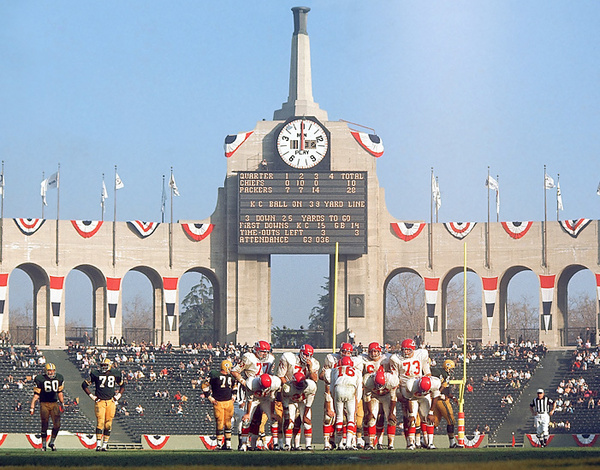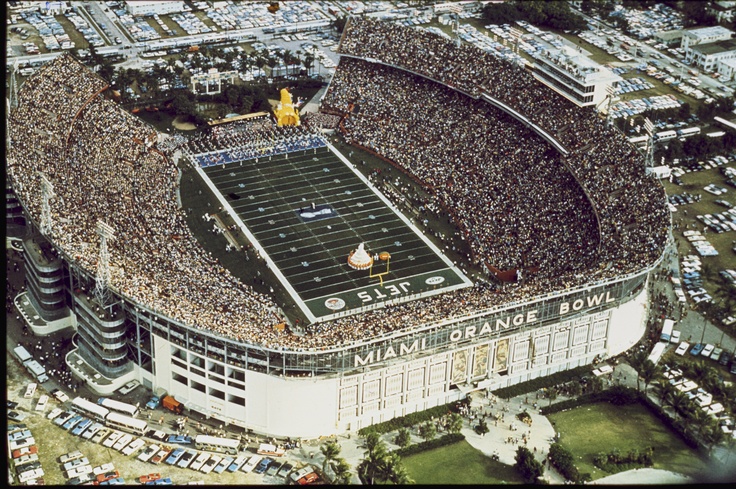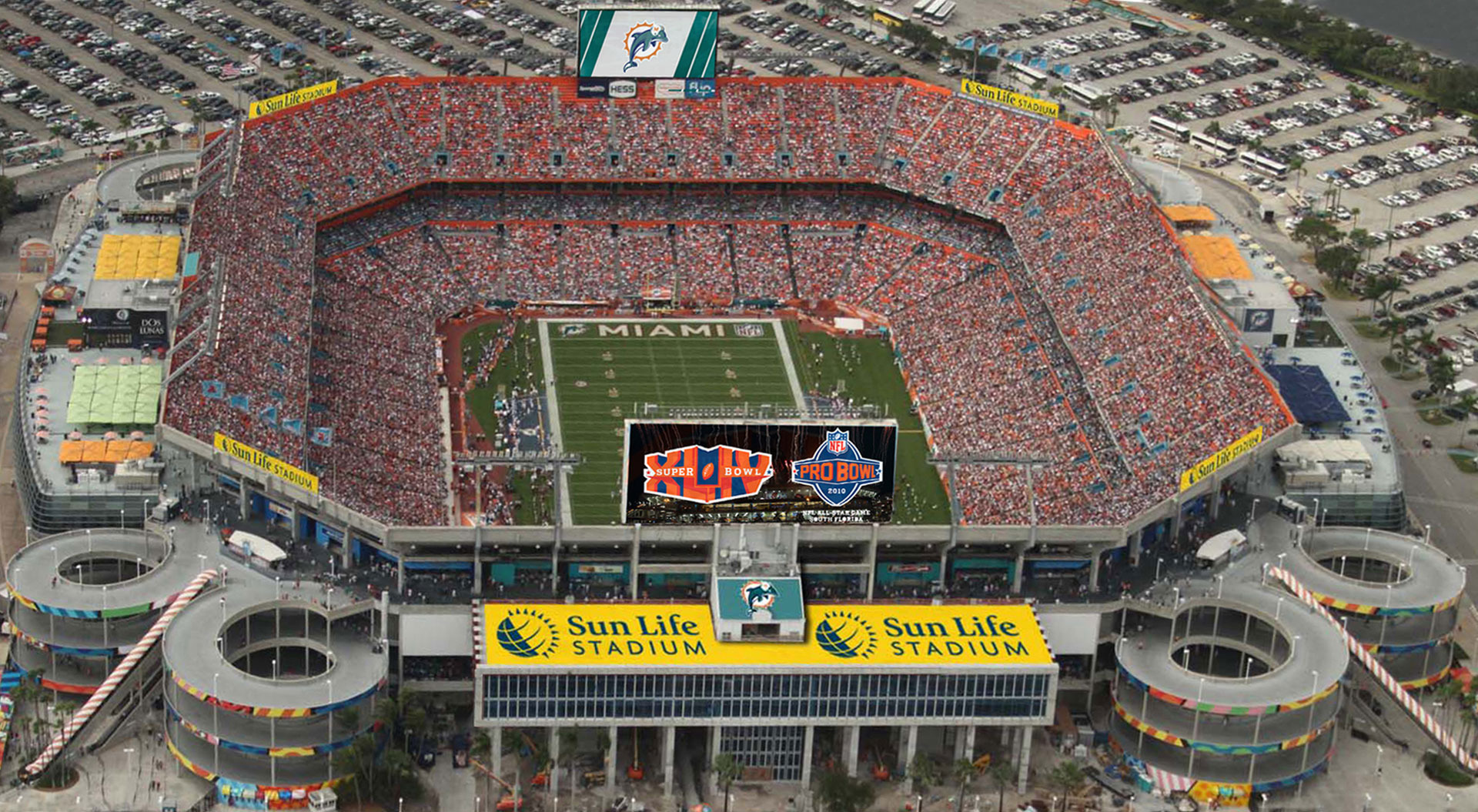The Super Bowl has been played in bowls, domes and a coliseum; under the sun and retractable roofs; before 63,000 in Minneapolis and in front of 100,000 in Arlington; in the warmth of Miami, the surprisingly temperate air of New Jersey and the even more surprising cold of New Orleans. The Super Bowl stadium has 49 years of history, and that history has brought it increasingly around the country, with unexpected results.
The very first Super Bowl — the AFL-NFL World Championship Game of 1967— was hosted by the Los Angeles Coliseum, home of the Los Angeles Rams. It was selected from a group of four finalists including the Astrodome, Orange Bowl and Tulane Stadium. No small wonder: influential members from the area lobbied hard to host the game; NFL Commissioner Pete Rozelle hailed from nearby; and the Rams had already brought in a crowd of over 100,000 ten short years earlier. This was the perfect opportunity, the NFL’s lords thought, to bring in another massive crowd. It did not work. With a TV blackout installed, chasing local residents out of town so as to be able to watch the game, the game drew a mere 61,946 as the Green Bay Packers blasted the Kansas City Chiefs.
By 1968, the World Championship Game had shifted over to the Orange Bowl, residence of the AFL’s Miami Dolphins and the University of Miami Hurricanes. The game did not go any better for the American Football League, as the Packers steamrolled the Raiders, but the game was a better success in attendance, bringing in 75,546. It did about the same number the next year, too, with the New York Jets upsetting the Baltimore Colts, thereby legitimizing the AFL and also installing our modern moniker for the game. There would be no future concerns about the game’s necessity. With the merger between AFL and NFL, the league’s proud championship game was here to stay.
From Super Bowl IV to Super Bowl XI, a system began to arise, shifting the game from arena to arena. Tulane Stadium, home of the Sugar Bowl, received its first hosting assignment in 1970 at Super Bowl IV and topped 80,000 in attendance. The game popped back into the Orange Bowl in 1971, bundled up in New Orleans again in 1972 — a game played in a chilly, blustery 39 degrees, which still holds the record as the lowest Super Bowl temperature — and made a triumphant return to the L.A. Coliseum in 1973. That second Super Bowl in Los Angeles lived up to its expectations, with a game-record crowd of 90,182 watching as the Dolphins finished a 17-0 perfect season with a 14-7 defeat of Washington.
Onward and upward from there: Super Bowl XI, in 1977, was the first to top 100,000 fans, packing the Rose Bowl in Pasadena to watch the Raiders throttle the Vikings. Super Bowl XII was back in New Orleans, but there were no worries of cold conditions now. It was the first Super Bowl to be held indoors, hosted on artificial grass at the three-year-old Louisiana Superdome. It was also the first Super Bowl to be moved later into the day in order to air in prime time. Kickoff was at 6:17 p.m. Eastern., 5:17 local time.
After cycling through again — the Orange Bowl for Super Bowl XIII, the Rose Bowl (with an attendance of 103,985) for Super Bowl XIV, and the Superdome once more for XV — the Detroit Lions’ Pontiac Silverdome received its first and only opportunity. It was a memorable one.
The Silverdome had been introduced in 1975, opening several weeks after the Superdome. Four years later, at the owners’ meetings in tropical Honolulu, Hawaii, the powers that be awarded the very first Super Bowl to a cold-weather site. No longer would the game be constrained to California, Louisiana, Texas, or Florida. Now, it could move. A precedent was set.
The weather in Michigan, predictably, was snowy; bless the invention of the dome. The game featured the San Francisco 49ers and the Cincinnati Bengals, two upstart teams making their first appearances in the Big Game and feeling mighty comfortable inside. The Niners grabbed a thrilling 26-21 victory, handing Joe Montana his first Super Bowl ring. The game drew a 73 share — 73% of people in the United States watched the proceedings, signifying over 85 million viewers. Football had arrived.
Though the game moved out of the Midwest to warmer climes in the years that followed, the owners were not done experimenting with new locales. Tampa Stadium, which had been around since 1967, hosted Super Bowl XVIII and XXV; Stanford Stadium set the scene for Super Bowl XIX; San Diego’s Jack Murphy Stadium welcomed in Super Bowl XXII; and the 49ers and Bengals met up again (in another classic) at Miami’s Pro Player Stadium for Super Bowl XXIII.
Super Bowl XXVI moved back up north. Way north, relative to the championship’s history. There has never been a Super Bowl more northerly than the 1992 tilt, pitting Washington against Buffalo at Minneapolis’s Hubert H. Humphrey Metrodome. This was not ignored by the organizers, either, who designed a “Winter Magic” salute to the Winter Olympics for intermission. There’s nothing quite like watching Olympic ice skating during halftime at a football game, particularly the biggest football game of the year.
The Dallas Cowboys won three of the next four Super Bowls, two of which were held in states experiencing their first Super Bowl hosting role. XXVIII occurred at the relatively new Georgia Dome in Atlanta, which opened for business in September 1992 and watched the Cowboys swamp the Bills only 16 months later. Tempe, Arizona, entered the party in 1996, housing another Dallas celebration at Sun Devil Stadium, home of Arizona State University’s football team.
There is a bit more back story here for Arizona than for Georgia.
Six years earlier, in 1990, the NFL had hand Super Bowl XXVII hosting duties to Sun Devil Stadium. Earlier than that, in 1987, Arizona governor Evan Mecham had walked back the state’s policy of observing Martin Luther King Day. This stirred up the hornets’ nest, leading to two different measures placed before the people in 1990 seeking to democratically connect the state with the rest of the nation in observing the holiday. Neither measure succeeded. A torrent of anti-Arizona sentiment flooded from coast to coast. The NFL felt this pressure and removed its invitation, relocating XXVII to the Rose Bowl. (It drew 98,374, watching a brilliant Michael Jackson halftime show and a 52-17 Cowboys embarrassment of the Bills.)
After Arizonans voted to approve MLK Day observance in 1992, the NFL owners granted them Super Bowl XXX. The state has since hosted two other Super Bowls, both at the Arizona Cardinals’ gorgeous home of University of Phoenix Stadium in Glendale.
Super Bowl XXXII was held at San Diego’s Qualcomm Stadium, known previously as Jack Murphy Stadium. This was its second Super Bowl, occurring ten years after initially hosting the Big Game. More interestingly, this was in 1998. Nine months after Super Bowl, in which John Elway, Terrell Davis, and the Denver Broncos edged the Packers by a touchdown, Qualcomm played host to the World Series between the San Diego Padres and the juggernaut that was Joe Torre’s New York Yankees. The Series did not end well for the homeowners, but it remains a memorable footnote of the first (and, to this point, only) year that a stadium has hosted the Super Bowl and World Series in the same calendar year.
1999’s Super Bowl XXXIII was supposed to have been held in San Francisco’s Candlestick Park, but the owners again reversed themselves. Candlestick’s planned renovations were not going through according to plan. It was best to stay safe, the owners decided, and they sent the game back to Miami. Life repeated itself for Super Bowl XXXVII: voted toward San Francisco and then stripped away due to concerns, delivered to San Diego instead. The San Francisco Bay area would not receive another opportunity to host the Super Bowl… until this Sunday’s Super Bowl XL at Levi’s Stadium.
As for Miami, it was just another notch in the city’s belt; the south Florida metropolis is tied with New Orleans with ten Super Bowl hosting nods.
The first Super Bowl hosted by a stadium with a retractable roof was XXXVIII. The Houston Texans’ Reliant Stadium (now NRG Stadium) opened in 2002 and gained its first Super Bowl in 2004, a thrilling 32-29 New England Patriots win over the Carolina Panthers. (NRG Stadium will host its second Super Bowl next year.)
Likely the most dubious Super Bowl casting choice occurred in 2005 with XXXIX. Jacksonville’s Alltel Stadium drew a fine crowd of 78,125, the largest attendance of any game between 1994 and 2010. Still, the city took more than its share of abuse. “How did Jacksonville get the Super Bowl?” wrote Tony Kornheiser in the Washington Post. “What, Tuscaloosa was booked?” There’s no sign nor likelihood that the Big Game will ever return to northern Florida.
From Jacksonville back up to Detroit: the Lions’ Ford Field, opened in 2002, hosted Super Bowl XL in 2006. Ford Field used FieldTurf, marking the first time that a Super Bowl would be played on a playing surface other than natural grass or AstroTurf. That was a triviality. The true headline was Pittsburgh running back Jerome “The Bus” Bettis. A native of Detroit, he returned home to the glory of a championship in his last season as a professional.
The Super Bowl headed south. The game dropped in on Jerry Jones’s vaunted JerryWorld for Super Bowl XLV — the extraordinary Cowboys Stadium in Arlington, Texas. Snowflakes and unseasonable cold weather made an unwelcome appearance in the lead-up to the game, though everything was clear by kickoff. A throng of 103,219 attended and 111 million watched the Super Bowl in 2011, witnessing a 31-25 Green Bay win over Pittsburgh.
The retractable roof was closed the next year, as the Hoosier State got in on the fun. Lucas Oil Stadium in Indianapolis made its Big Sunday debut to fine feedback. Concluded Larry Olmsted for Forbes, “By halftime locals were talking about when, not if, the NFL would return to Indy with another Super Bowl….” By game’s end, the talk was of the New York Giants’ Eli Manning. Playing on his older brother’s home field, Manning completed a second stunner of a Super Bowl victory over Tom Brady and the New England Patriots, 17-14.
If Indianapolis fared well as a rookie, New Orleans’ Superdome fared unexpectedly poorly as a seven-time veteran the next year. During the third quarter of Super Bowl XLVII, the facility lost power for 22 minutes, delaying the game over half an hour. Five days later, Energy New Orleans, Inc., blamed an electrical relay device for the loss in power. Before the lights went out, the Baltimore Ravens led the San Francisco 49ers by 22 points. Afterward, the Ravens hung on tight for three-point win.
It seemed more more stress was coming the next season. Colder-weather towns Washington, D.C., and East Rutherford, New Jersey, had made several bids for a Super Bowl through the years. In 2010, the NFL acquiesced, handing Super Bowl XLVIII to the newly-opened MetLife Stadium in East Rutherford. It was enough to cause shivers: The contest would be played in New Jersey on early February, outside, on natural grass. Thoughts faded back to Super Bowl VI all those years ago, with the 39-degree temps of New Orleans. Would a new record be set? Not a bit. 49 degrees greeted the teams and fans at kickoff.
Twelve seconds in, though, a wild snap sailed past Denver Broncos quarterback Peyton Manning into the end zone, resulting in a safety. That, at least, was a record: the quickest points scored in a Super Bowl game. Seattle stomped Denver 43-8 on a mild night for everyone but Broncos fans. The next day, the anticipated snow arrived in New Jersey.
Perhaps heartened by the experience, the NFL has announced the site for 2018’s Super Bowl LII — the not-yet-open U.S. Bank Stadium, due to be opened in Minneapolis in the near future. Consider the possibilities: Early February in Minnesota. It’s all part of the Big Game experience.
Staying in the past, for the moment, it’s fun to gather all of these Super Bowls together and sort them, as if dividing a deck of cards into suits, and then shuffling them up and sorting by number. 23 different stadiums have hosted the 49 Super Bowl games in 10 different states. Of these, the L.A. Coliseum, Jack Murphy/Qualcomm, Metrodome and Pro Player/Sun Life each hosted Major League Baseball games in addition to football games in their history. Some of these Super Bowl stadiums are now gone; there’s no more Stanford Stadium (since the Super Bowl gig the stadium was toen , or Tulane Stadium, or Metrodome or Silverdome.
Of those 49 Super Bowl games: 39 were at night and 10 were during the day; only six games featured fewer than 70,000 fans while five drew more than 100,000 in attendance; 15 games were played in Florida, 12 games in California, and 11 in Louisiana, distancing those cities; and 10 games were played in a dome (seven in the Superdome), while two were played under retractable roofs (Lucas Oil and Reliant/NRG). It has never snowed during game action of the Super Bowl.
Then again, considering the history of the event — stretching from Martin Luther King’s legacy to a power outage — you never know what could be around the bend next.



